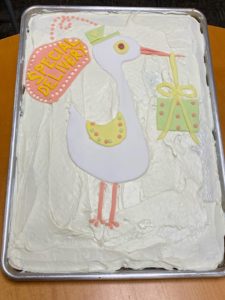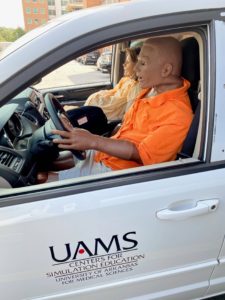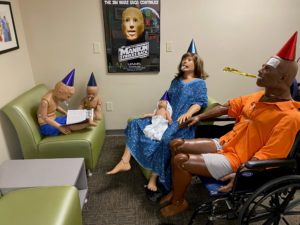UAMS Centers for Simulation Education Takes to Twitter to Discuss Maternal Health
| Staff in the University of Arkansas for Medical Sciences (UAMS) Centers for Simulation Education spent the week of Sept. 13 highlighting Arkansas’ problematic maternal and fetal mortality rates while sharing UAMS’s efforts to bring that number down.
To simultaneously commemorate Healthcare Simulation Week 2021, showcase UAMS’ efforts and focus attention on a serious issue in Arkansas, Karen J. Dickinson, M.D., assistant professor of surgery and director of Interprofessional Education Simulation and Clinical Skills Training, came up with a fun plan of social media posts centered on a theme of maternal health.
Healthcare Simulation Week celebrates health care professionals across the globe who use simulation to improve the safety, effectiveness and efficiency of health care delivery, and to raise awareness in communities nationwide about how health care simulation is leading to safer, more knowledgeable patient care.
Dickinson chose the maternal health theme because reducing the maternal and fetal mortality rates in Arkansas is one of the issues that UAMS is striving to address under the Vision 2029 Strategic Plan. That year will mark UAMS’ 150th anniversary as the first medical school in Arkansas, and the goal is for UAMS to lead Arkansas to be the healthiest state in the region.
America’s Health Rankings’ 2019 Health of Women and Children Report ranked Arkansas 46th out of 50 states in maternal mortality. A 2020 report by the same group that focused on infant mortality ranked Arkansas in 48th place, with 8.2 infant deaths per 1,000 live births.
Several tweets from the UAMS Centers for Simulation Education account (@UAMSSIMCENTER) were shared on the Healthcare Simulation Week 2021 Twitter page, which is in association with the Society for Simulation in Healthcare. The UAMS tweets were interspersed with others describing a variety of simulation events at institutions around the world. In fact, more than 500 simulation centers worldwide engaged with the “Healthcare Simulation Week Map.”
The lighthearted UAMS tweets told the story of a couple expecting a child as the narrative developed over the course of the week and were illustrated by photos of manikins in the Simulation Center. Alongside this, the tweets also highlighted the high-quality maternal mortality focused simulations conducted at UAMS, including those led by Faiza Khan M.D., associate professor of anesthesiology, and Luann Racher M.D., assistant professor of obstetrics and gynecology.
“At UAMS, we have taken the time and effort to develop collaborative teams that work towards enhancing maternal care and reducing maternal morbidity and mortality,” Khan said. She added the anesthesia, obstetric and nursing teams have collaborated to participate in crisis events, including maternal cardiac arrest, post-partum hemorrhage, urgent cesarean delivery, eclampsia and hypertensive crisis, anesthesia complications as well as other maternal emergencies.
Dickinson and the UAMS Centers for Simulation staff brainstormed the storyline for the theme of the week. Day One of the fun events began with a photo of a cake depicting a stork arriving with a special delivery. The following days showed photos of a pregnant manikin being driven to a hospital by her panic-stricken partner; Simulation Center staff with the expectant father as he anxiously checks his watch; the mother ready to deliver, legs in stirrups, while the baby’s father has fainted next to the bed; and finally, the successful birth of the baby, as illustrated by the relieved family wearing party hats and sitting around the mother, still in a gown with baby on her lap.
Assisting in the week’s activities were Margaret Glasgow, Sherry Johnson, Patti Griffey, Andrew Warr, Jerry Halpain, Dewayne Allen and Travis Hill.
“It’s a fun way for our Simulation Center to showcase the great work being done here by many colleges and departments, but at the same time it shows the serious side: how educational initiatives within our center are making a difference, in line with UAMS’ 2029 Strategic plan,” Dickinson said.
The shared ideas are meant to inspire activities for simulation labs around the globe.
“It helps you become part of the community alongside other simulation professionals with shared interests and goals,” Dickinson said. “It also gives us a chance to increase awareness of our center and our educational programs both nationally and internationally.”




